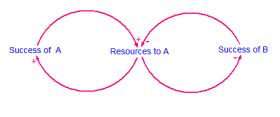Success to the Successful
 My first introduction to the Systems Archetypes was years ago when I read Peter Senge’s book, The Fifth Discipline. I remember relating these classic Systems Thinking stories to my own experience in business and thinking how useful it was to understand some of the problems we faced and why solutions didn’t always work out as intended.
My first introduction to the Systems Archetypes was years ago when I read Peter Senge’s book, The Fifth Discipline. I remember relating these classic Systems Thinking stories to my own experience in business and thinking how useful it was to understand some of the problems we faced and why solutions didn’t always work out as intended.
What I’ve come to appreciate since then is how the characteristic themes of the Systems Archetypes transform across all sorts of different fields and situations — even our personal lives!
Take, for example, the basic story line of the “Success to the Successful” archetype:
When given the choice, we invest our resources where we expect them to deliver the best results. By giving more resources to one option over another, we create a self-fulfilling prophesy whereby the favored option is perpetually more successful.
The story of the Success to the Successful archetype applies to all sorts of situations leading to well-known patterns of behavior:
- rich getting richer and poor getting poorer
- winners being rewarded with the means to win again
- popular brands attracting more popularity
- one species driving another to extinction
- top salespeople being paid higher commissions
Exploring the Model Structure
We recently published a model of the Success to the Successful archetype to the web using isee NetSim. Exploring the model is a great way to understand the underlying structure of the  system and think about ways to avoid the problems it creates.
system and think about ways to avoid the problems it creates.
You’ll also get an appreciation of how the decision policy for allocating resources can determine success rather than competence.
Running the Simulation
After you’ve explored the model, try running a simulation. The base case scenario assumes no one has an advantage over the other. As you can imagine, everyone is equally successful and it’s a win-win situation. Try turning on the “Advantage A Switch” to see how even a modest advantage for A can snowball into a disadvantage for B. It’s surprising how quickly the gap can widen.
Using Modules to Create Models
In STELLA and iThink version 9.1, we added the ability to build models by linking together modules. The Success to the Successful model is an example of how you can use modules to create a higher level map of your model. This map can easily be presented as a causal loop diagram.
The beauty of modules is they simplify the process of transitioning from a CLD to a model that actually simulates. If you’ve ever tried to convert a causal loop diagram into a stock and flow model, you can appreciate what I’m talking about! By architecting your model into modules, you’ve got a built-in mechanism for developing your model in manageable chunks and communicating the high level causal relationships.